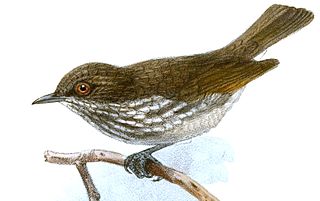
The blue-crowned racket-tail is a parrot found endemic to the Philippines. It is 27cm, basically green with a blue crown, bluish undertail, whitish beak, and dark underwings with green coverts. It was formerly conspecific with, Mindoro racket-tail and Blue-headed racket-tail

The brown tit-babbler is a species of bird in the family Timaliidae. It is endemic to the Philippines. Its natural habitats are tropical moist lowland forest and or tropical moist montane forest.

The ashy-headed babbler is a species of passerine bird in the ground babbler family Pellorneidae. The species is also known as the ashy-crowned babbler. The species is closely related to the short-tailed babbler. The two species are sometimes treated as the same species but differ in their calls. The species is monotypic, meaning it has no subspecies.

The melodious babbler is a species of bird in the family Pellorneidae. It is endemic to the Philippines and found only on Palawan and Balabac.

The Visayan miniature babbler or the Leyte plumed-warbler is a bird species in the family Cisticolidae.

The falcated wren-babbler is a species of bird in the family Pellorneidae. It is endemic to Palawan.

The striated wren-babbler is a species of passerine bird in the Pellorneidae family. It is endemic to the Philippines found on the islands of Bohol, Samar, Leyte, Basilan, Dinagat Islands and Mindanao. Its natural habitats are tropical moist lowland forest and the lower reaches of tropical moist montane forest.

The rusty-crowned babbler is a species of bird in the family Zosteropidae. It is native to the southern Philippines on the islands of Mindanao and Dinagat Islands and Basilan. Its natural habitat is tropical moist lowland forest.

The golden-crowned babbler is a species of bird in the family Zosteropidae. It is endemic to the Philippines found only in the moist tropical forest in Northern Luzon. It is threatened by habitat loss.

The Palawan striped babbler is a species of bird in the family Zosteropidae. It is one of the four striped babblers along with the Negros striped babbler, Panay striped babbler and Luzon striped babbler. It is endemic to the Philippines, where it is only found in Palawan. Its natural habitat is tropical moist montane forest. It is threatened by habitat loss.

The Panay striped babbler is a species of bird in the family Zosteropidae and was completely unknown to science until its discovery in 1987 and designation as its own species in 1990. It is endemic to the Philippines only being found on the island of Panay. Its natural habitat is tropical moist montane forest. It is threatened by habitat loss.

The Visayan babbler also known as the Visayan Black-crowned Babbler. is a species of bird in the family Zosteropidae. It is endemic to the Philippines. It is found on Samar, Leyte and Bohol. Its natural habitat is tropical moist lowland forest. It was formerly conspecific to the northern population of the Calabarzon black-crowned babbler but has since been split as a species due to differences in its yellowish throat and whiter belly.

The Negros striped babbler is a species of bird in the family Zosteropidae. It is endemic to Negros Island in the Philippines. Its natural habitat is tropical moist montane forest in the range of 900–1,600 masl. It is threatened by habitat loss.

The Mindanao pygmy babbler is a bird species endemic to the Philippines. It had been placed in the family Timaliidae, but it is a close relative of the white-eyes, however, and many taxonomists now place it in the family Zosteropidae..

The Luzon striped babbler is a species of bird in the family Zosteropidae. It is one of the four striped babblers along with the Negros striped babbler, Panay striped babbler and Palawan striped babbler. It is endemic to the Philippines, where it is only found in northern Luzon and in Bataan. Its natural habitat is tropical moist lowland forest. It is threatened by habitat loss.

The Visayan pygmy babbler is a bird species endemic to the Philippines on the islands of Leyte and Samar. It was conspecific with the Mindanao pygmy babbler under the common name of "pygmy babbler".Its natural habitats are tropical moist lowland forests and or tropical moist montane forests.

The chocolate boobook is a bird species in the true owl family, Strigidae. It was formerly considered to be a subspecies of the brown boobook. It was formerly thought to be endemic to the Philippines until it was heard and recorded Karakelang in Indonesia in 1997 but there have been no subsequent records outside the Philippines since.

The Palawan bulbul or grey-throated bulbul is a species of songbird in the family Pycnonotidae. It is endemic to Palawan Island in the Philippines. Its natural habitats are tropical moist lowland forests and tropical moist montane forests.

The Bicol ground warbler is a species of passerine bird in the family Locustellidae. It is native to southern Luzon and Catanduanes in the Philippines. It was formerly conspecific and forms a species complex with the Cordillera ground warbler and Sierra Madre ground warbler, which are some of most elusive birds in the country due to their extremely shy nature. Its natural habitat is tropical moist lowland forest. It is threatened by habitat loss.

The Calabarzon babbler is a species of bird in the family Zosteropidae. It is endemic to the Philippines found in the island of Luzon. Contrary to its name, it is also found outside the Calabarzon region where it also inhabits Central Luzon, Bicol Peninsula and Catanduanes. Its natural habitat is tropical moist lowland forest. It previously was considered a subspecies of the black-crowned babbler.




















